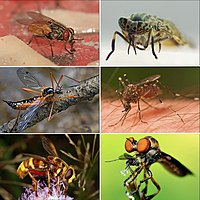
Photo from wikipedia
An entomological survey was carried out in the locality of Aichoune to conduct a study on sand flies, species composition, and monthly relative abundance. This study is essential for the… Click to show full abstract
An entomological survey was carried out in the locality of Aichoune to conduct a study on sand flies, species composition, and monthly relative abundance. This study is essential for the implementation of integrated vector management control. Insects collection was carried out twice a month from January 2013 to December 2014 by means of adhesive and CDC-type light traps. A total of 5441 sand flies were collected with the predominance of males (a sex ratio = 1.89). The sampled specimens consist of seven species divided into two genera: Phlebotomus (99.55%) and Sergentomyia (0.44%). Phlebotomus sergenti was the dominant species with an average annual proportion of 47.38%, followed by P. perniciosus (37.32%), P. longicuspis (8,56%), P. papatasi (6.23%), and P. ariasi (0.05%). The genus Sergentomyia was less common (0.44%). S.minuta was represented only by 0.36% and S. fallax by 0.07%. The species dynamics showed a unimodal evolution for P. sergenti and P. papatasi. They were active from May to October. P. perniciosus presents a trimodal trend showing the most relevant peak in August. The highest number of specimens was collected in June, when the temperature reaches an annual average value of 25.5°C. The obtained results will help us better understand the leishmaniasis transmission dynamics in the Aichoune locality and will contribute to the design of a surveillance strategy.
Journal Title: The Scientific World Journal
Year Published: 2022
Link to full text (if available)
Share on Social Media: Sign Up to like & get
recommendations!